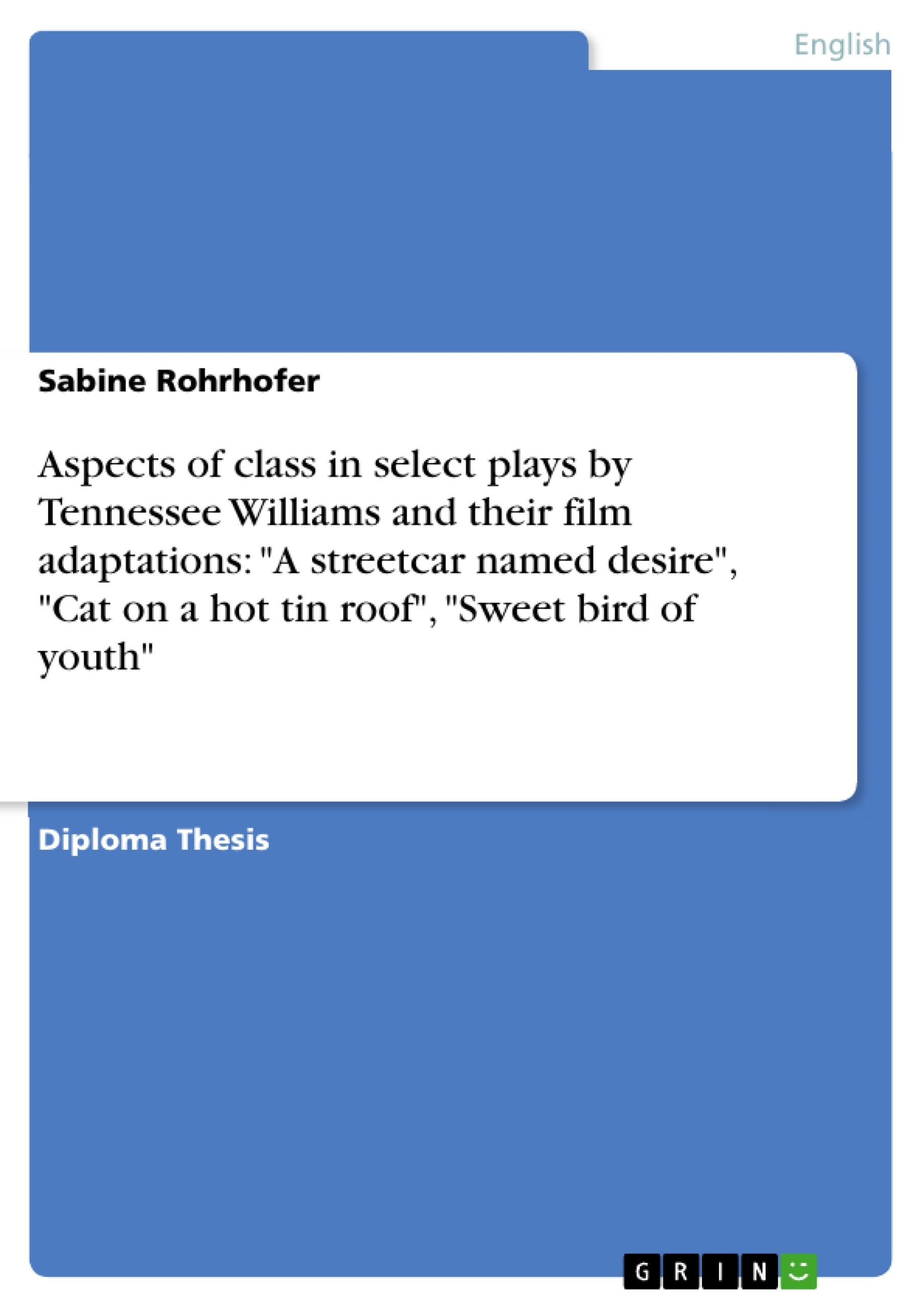Tennessee Williams is one of America's greatest playwrights whose talents of creating tension and atmosphere went beyond the métier of theatre and were convincing in the field of motion pictures, too. Elia Kazan, the successful theatre and film director, particularly admired the artist’s gift of evoking emotions.
In this thesis, however, I shall not attempt at evaluating Williams’s total works. Rather, my object is a comparative analysis of select plays by Tennessee Williams and of their film adaptations: A Streetcar Named Desire (1947, 1951), Cat on a Hot Tin Roof (1955, 1958), and Sweet Bird of Youth (1959, 1962). Special attention has been given to examining the social differences in the plays and films. By focussing on the methods of characterisation employed I shall investigate more or less typical class representations in the two different media. I shall work out the social politics of the playwright, theatre and film directors, and – as far as possible – the actors’ and actresses’ contributions to the dramatic contents. The multitude of interpretations and variations usually gives proof to the value of artistic works.
The methods applied in this thesis are literary research and film studies. As a matter of course, I analysed the plays on their written basis, which raises the general question to what extent the perceptions by the audience and the reader differ. ‘The readers of a play must use their imagination to flesh out the characters, and to place them in an appropriate setting’ (Sambrook, 6). Williams gives very precise and evocative stage directions, which help the reader to imagine the situations in many details. Meaning is often conveyed by poetic images. By employing figurative language he tries to ‘paint a word picture or convey in words the quality of a sound’ (Sambrook, 48). The critic also notes that in Streetcar, these stage directions contrast and ‘serve to underline the uneducated speech’ (Sambrook, 14) of most characters, except for the DuBois sisters. The audience of a play or film, on the other hand, cannot perceive these aspects; rather, the spectators are confronted with a particular setting and with concrete actors and actresses. ...
Inhaltsverzeichnis (Table of Contents)
- Introduction
- The Concept of Class
- Film Theories
- Tennessee Williams
- Some Biographical Notes
- The Plays
- A Streetcar Named Desire
- Cat on a Hot Tin Roof
- Sweet Bird of Youth
- Aspects of Class in the Plays
- The Film Adaptations
- Tennessee Williams and Hollywood
- A Streetcar Named Desire
- Cat on a Hot Tin Roof
- Sweet Bird of Youth
- Aspects of Class in the Film Adaptations
Zielsetzung und Themenschwerpunkte (Objectives and Key Themes)
This thesis aims to analyze select plays by Tennessee Williams and their film adaptations, focusing on the social differences presented in both mediums. It investigates class representations in these works, exploring how characterization methods contribute to the portrayal of social dynamics. The analysis examines the perspectives of the playwright, directors, and actors, highlighting the nuances and variations within the artistic interpretations.
- Class representations in Tennessee Williams’s plays and film adaptations
- The role of characterization methods in depicting social differences
- The influence of the playwright, directors, and actors on the portrayal of class
- Comparative analysis of the different mediums: theatre and film
- Exploration of the social politics embedded in the works
Zusammenfassung der Kapitel (Chapter Summaries)
- Introduction: This chapter introduces the concept of class and its multifaceted interpretations. It discusses the significance of social differences in Williams’s plays and film adaptations, emphasizing the focus on characterization and social dynamics.
- Tennessee Williams: This chapter provides biographical context for understanding Williams’s work, highlighting his talents in creating dramatic tension and atmosphere.
- The Plays: This section explores the three plays under analysis: A Streetcar Named Desire, Cat on a Hot Tin Roof, and Sweet Bird of Youth. It focuses on the portrayal of class within each play, highlighting the specific character dynamics and social contexts.
- The Film Adaptations: This section examines the film adaptations of the three plays, focusing on the influence of Hollywood and the specific contributions of directors and actors. It analyzes how class is represented in the film adaptations and compares them to their theatrical counterparts.
Schlüsselwörter (Keywords)
This thesis examines key concepts like class, characterization, social differences, theatre, film adaptation, Tennessee Williams, A Streetcar Named Desire, Cat on a Hot Tin Roof, Sweet Bird of Youth, and the social politics embedded within these works. The analysis utilizes literary research and film studies to understand how class is portrayed and interpreted in both mediums.
- Quote paper
- Sabine Rohrhofer (Author), 2002, Aspects of class in select plays by Tennessee Williams and their film adaptations: "A streetcar named desire", "Cat on a hot tin roof", "Sweet bird of youth", Munich, GRIN Verlag, https://www.grin.com/document/4764




